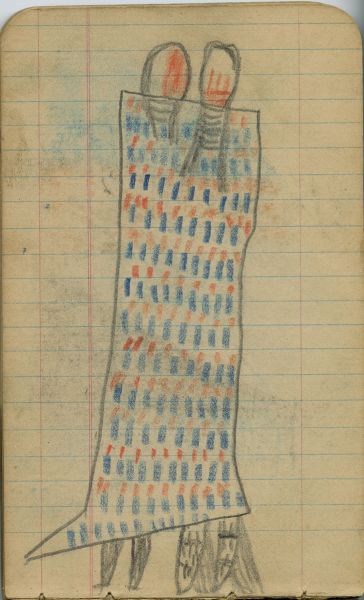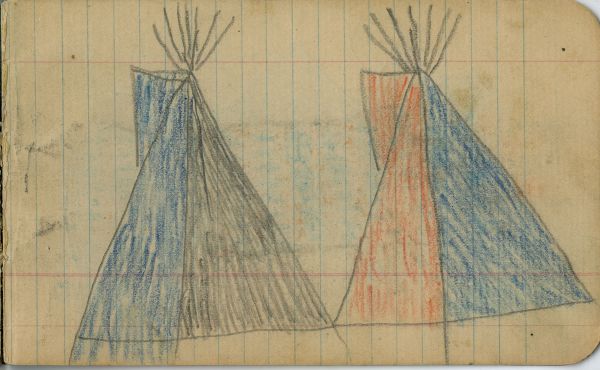COURTSHIP: Courting Couple in Decorated Blanket; CAMP: 2 Tipis: Blue/Black, Red/Blue
Ethnographic Notes
p. 42 COURTING. Couple Wrapped in Blanket Decorated with Red and Blue Dashes The drawing is horizontal, so the top is the lefthand edge of the page. The man, to the right, paints the lower half of his face red with three vertical lines. He wears a necklace of seven strands. His gray breechcloth ends drag the ground. He has abbreviated feet with no moccasins, but his leggings show dragonfly designs, gray on white. Imre Nagy writes this about dark dragonflies: "Dark bluish-green dragonflies signify the green darner, the vernal Anax junius, which invokes the deep waters and the dark night sky. It is necessary to emphasize that these dragonflies are vernal because the same dragonfly has a pruinose phase (a later, whitish phase) during which it is considered a �white� dragonfly in Cheyenne terms and connotes a different cosmological meaning than dragons in the vernal phase. Anyone carrying the vernal, bluish-green dragonfly image is capable of overcoming the terror of death. In order to hatch from deep waters�which in turn are associated with the night sky and death�the dragonfly must struggle with the dark forces. The ability to overcome dark forces and death makes dragonflies ideal protective symbols on shields and lodge covers, as well as for curing and war charms" (2003: 212-3). Michael Cowdrey writes this of dragonflies: "The painted design [ on a Southern Cheyenne dance shield, ca. 1880, Denver Art Museum, Cat. No. PChy II.G] represents two vovetas (dragonflies), which Cheyennes associate with the generative power of whirlwinds (Moore, 1974: 155-157)" (1999: 47). The woman has half her face vertically painted red. She wears strands of a necklace, and her leggings that show beneath the blanket are solid gray, probably trade cloth (lead pencil). The blanket, outlined in pencil, has alternating rows of small dashes. This motif appears elsewhere in tipi designs (Plate 3) and courtship blankets (Plates 6, 7). Media: Lead pencil and details; blue and red crayon details p. 43 CAMP. Two Tipis, Blue/Black and Red/Blue Two tipis stand next to each other, covering the page. These resemble the tipis in Plate 4. X-ray vision makes it possible to see through the overlapping sides. Seven poles are drawn in the left tipi gathered at the smoke holes of both tipis. The tent flaps are open. Each tipi has a line bisecting it vertically down the middle. The first tipi, to the left, has blue on the left and gray (lead pencil) on the right half. Blue coloring goes off the bottom of the page, outside the tipi outline. The right-hand tipi has orange fill on the left half and blue on the right half. The line that bisects it vertically runs off the bottom of the page, outside the tipi outline. Media: Lead pencil outline, details, fill; blue and orange crayon fill


